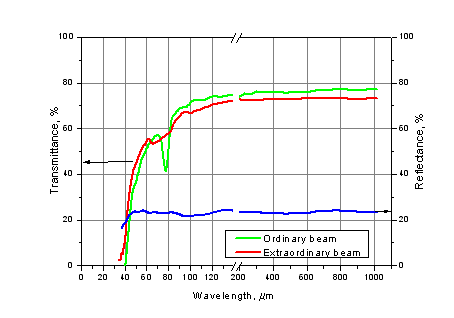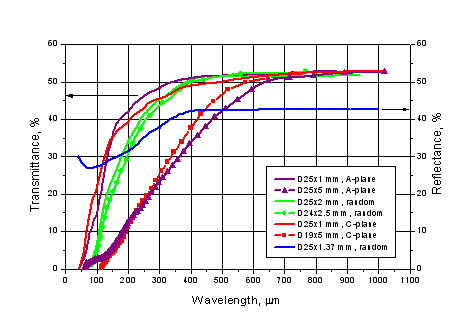THz_Materials常用太赫兹材料说明
THz Materials 常用太赫兹材料说明
- Golay Cells
- Hardware-software Complex for Operating Golay Cell
- THz Scanning Fabry-Perot Interferometer
- THz Impulse Radiation Electro-Optical Detector
- RF Thermoacoustic Detector ТАD-1
- THz Low Pass Filters
- THz Band Pass Filters
- THz Polarizers
- THz Atteniators
- THz Windows
- THz Lenses
- THz Prisms
- THz Mirrors
- THz Waveplates
- THz Broad-band Phase Transformers
- THz Spectral Splitters
- THz Beam Splitters
- THz Diffractive Optical Elements
- THz AR Coatings
Terahertz (THz) radiation is located in the spectral region ~0.1-10 THz (~3 mm - 30 μm, 3 cm-1 - 300 cm-1) between the microwave and mid infrared range of the electromagnetic spectrum.
In comparison with visible or infrared waves, THz radiation can penetrate into organic materials such as skin, plastics, cloth, or paper products. Because of low photon energy involved, it does not cause any damage associated with ionizing radiation ( e.g. X-rays). THz waves do not penetrate into metals. These properties can be used in process (e.g. drugs manufacturing) and quality control as well as in THz imaging. It is also of great current interest for such applications as safety control, packaging inspection, semiconductor characterization, chemical composition analysis, and biomedical investigations, with great promise for spectroscopy, defense imaging, and security applications.
Traditionally for THz applications we use High Resistivity Float Zone Silicon (HRFZ-Si) as it is the most investigated substance for operating within this range and has a good transmission performance. In parallel with this material we have been investigating other materials which also can be utilized in THz range.
Below you can see transmission spectra and other characteristics of materials we use for THz optics production. Measurements in THz region were made at ABB FTIR spectrometer Bomem DA3 and Bruker IFS 125HR (measure of inaccuracy is 2-3% below 100 µm and 4-5% over 100 µm). Measurements in near infrared range were made at Perkin Elmer “Lambda- 9” (measure of inaccuracy < 0.5%).
The crystals such as silicon, crystal quartz, and sapphire are important for THz optics production.
1.1 High Resistivity Float Zone Silicon (HRFZ-Si)
Besides synthetic diamond high resistivity sillicon is the only isotropic crystalline material suitable for the extremely wide range from NIR (1.2 µm) to MM (1000 µm) waves and more. In comparison with diamond it is rather cheaper to grow and machine. Moreover it may have considerably bigger dimensions that allows manufacturing the elements of fast-developing THz electronics based on that. For THz applications we offer High Resistivity Float Zone Silicon (HRFZ-Si) maintaining 50-54% transmission to 1000 µm (and for longer wavelengths up to 3000 and even to 8000 microns).
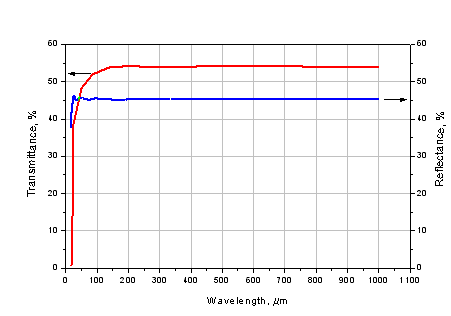
Fig.1 Transmission and reflection of HRFZ-Si 5.0 mm-thick sample in THz range.
HRFZ-Si has low losses in THz range. As follows from Fig. 2 the THz waveform of HRFZ-Si is similar to the THz waveform of air. That indicates the lack of HRFZ-Si absorption.
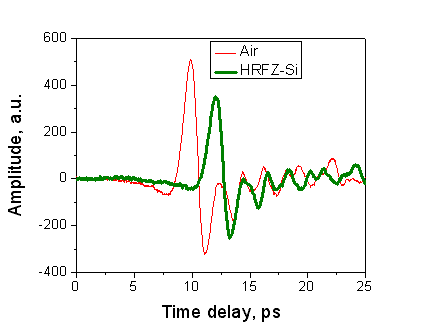
Fig.2 The THz signals transmitted through air and HRFZ-Si.(*)
The complex dielectric permittivity of silicon depends on its conductivity (i.e. free-carrier concentration). Figure 3 shows the dielectric permittivity of silicon at 1 THz with different impurity concentration. For low impurity concentration the dielectric permittivity is almost a real value, which is approximately equal to the high frequency dielectric permittivity. As a level of impurity concentration increases the real part of the dielectric constant becomes a negative value and its imaginary part can't be considered negligible anymore. The dielectric permittivity presents its complex nature and silicon becomes lost to THz wave. Loss tangent can be calculated using the following formula: tanδ=1/(ω*εv*ε0*R), where ω - circular frequency, εv - dielectric constant of vacuum (8.85*10-12 F/m), ε0 - dielectric constant of silicon (11.67), and R - specific resistance. For example, loss tangent of HRFZ-Si with resistivity 10 kOhm*cm at 1 THz is 1.54*10-5.
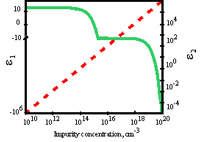
Fig.3 Real (solid, ε1) and imaginary (dashed, ε2) part of dielectric permittivity of n-type silicon with different impurity concentration at 1 THz.(**)
More about general characteristics of Silicon as well as transmission spectrum within NIR and MIR range can be found in the chapter Silicon.
1.2 Crystal quartz
One of the best materials for wavelengths above 50 µm is z-cut crystal quartz. It is important that z-cut crystal quartz windows are transparent in the visible range allowing easy adjustment with HeNe laser, do not change the state of light polarization, and can be cooled down below the λ-point of liquid helium.
Fig.4 Transmission and reflection of crystal quartz 1.0 mm-thick sample.
Due to quite big dispersion (please see the table below) lenses made of crystal quartz will have different focal lengths at visible and far infrared ranges. It should be taken into account if you are going to use such lenses for optical systems alignment:
|
Crystal quartz is birefringent material that should be noted if the polarization of radiation is important. We use x-cut material to produce λ/2 and λ/4 waveplates for usage at THz wavelengths.
More about general properties of crystal quartz as well as transmission spectrum within UV and visible range, you can find at chapter Synthetic Crystal Quartz.
1.3 Sapphire
Sapphire like crystalline quartz is transparent in THz region as well as in visible one. Samples of various crystallographic orientations and thickness were measured. As can be seen from below spectra transmission doesn't depend on crystal orientation within measure of inaccuracy. For measured samples with thicknesses from 1 to 5 mm transmission lower 600 µm strongly depends on sample thickness. The transmission approaches to saturation at shorter wavelengths for thinner samples.
Fig. 5 Transmission and reflection of sapphire samples with different thickness.
Like HRFZ-Silicon, sapphire also can be used for manufacturing of photoconductive antennas for THz because of similar refractive index value in THz.
More about general properties of sapphire as well as transmission spectrum within UV and visible range you can find at the chapter Sapphire.
2. Polymers
Among large variety of available polymers there are some of excellent terahertz transparencies with relatively low reflectivity. The best materials in this sense are TPX (polymethylpentene), polyethylene (PE), polypropylene (PP), and polytetrafluoroethylene (PTFE or Teflon). At longer wavelengths, the transmission of these polymers is structureless and flat. Going to shorter wavelengths, mainly below 200 µm, characteristic bands of intrinsic vibrations appear and scattering due to inhomogeneities increases. Polymers generally become increasingly opaque at shorter wavelengths.
TPX is the lightest of all known polymers. It is optically transparent in UV, visible, and THz ranges, what for example allows using a HeNe laser beam for alignment. Index of refraction is ~1.46 and is relatively independent on wavelength:
|
Losses are very low up to mm-wavelengths. TPX has excellent heat resistance and is highly resistant to most organic and inorganic commercial chemicals.
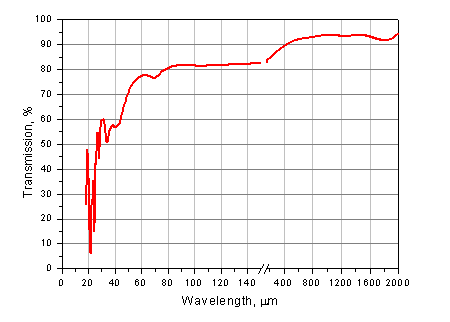
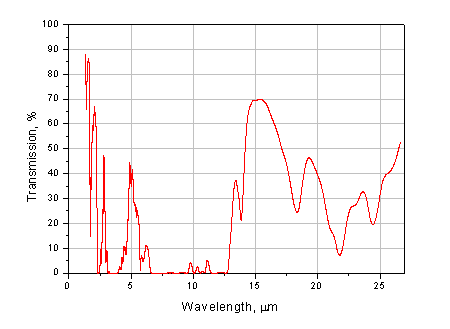
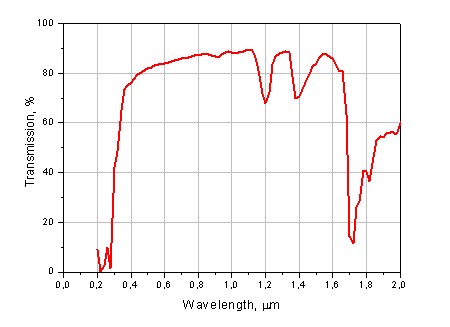
Typical properties of TPX
|
TPX is a hard solid material which can be mechanically shaped into various optical components like lenses and windows. Also specifically TPX is used in CO2 laser pumped molecular lasers as output window because it is transparent in the whole terahertz range and totally suppresses the ~10 µm pump radiation. Also TPX windows are useed in cryostats as "cold" windows. The THz transparency of TPX does not change in dependence on temperature. Temperature coefficient of refractive index is 3.0*10-4 K-1 (for the range 8-120 K).
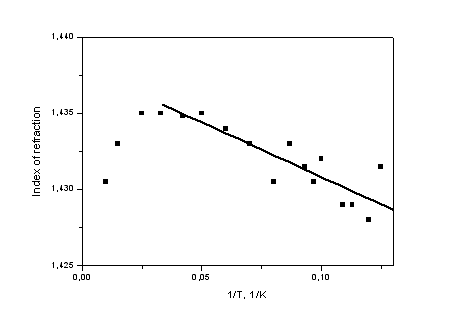
In comparison with other materials being used for operating in THz range TPX shows excellent optical properties and for example can be good substitution for Picarin (Tsurupica) lenses. In addition TPX is cheaper and commercially available in opposite to Picarin.
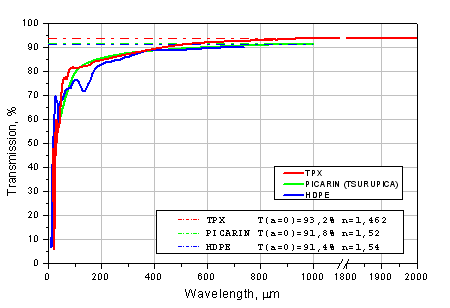
2.2 Polyethylene (PE)
PE is light elastic crystallizing material. It can be heated up to 110°C and cooled down to -45 ÷ -120°C depending on grade. PE has good dielectric characteristics, chemical resistance, and radioresistance. Contrariwise, it is unstable to UV-radiation, fats, and oils. PE is biologically inert, is easy to be processed. Density (23°C) is 0.91-0.925 g/cm3. Tensile flow limit (23°C) is 8-13 MPa. Modulus of elasticity (23°C) is 118 - 350 MPa. Refractive index is ~1.54 and is rather equal within wide wavelength region. Usually high-density polyethylene (HDPE) is used for component's production. Besides quite thick lenses and windows, thin HDPE films are used for THz polarizers. In addition, we use HDPE as the window for Golay cells.
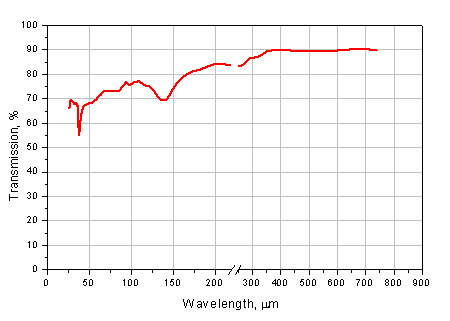
Fig. 11 Transmission of 2 mm-thick HDPE sample. THz region.
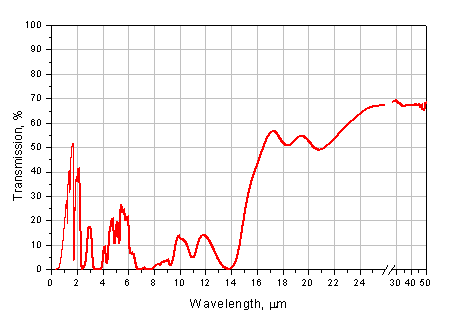
Fig. 12 Transmission of 2 mm-thick HDPE sample. NIR&MIR region.
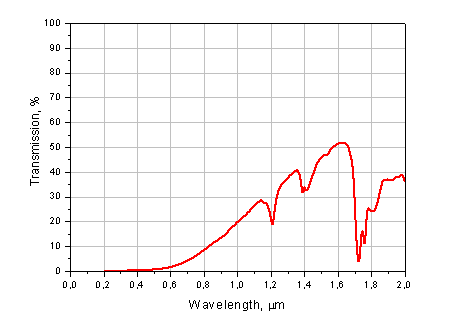
Unfortunately, HDPE transmission in visible region is very poor, thus it can't be used for adjustment of optical systems.
Should notice that THz transmission of HDPE doesn't depend on temperature that allows using HDPE windows in cryostats. Temperature coefficient of refractive index is 6.2*10-4 K-1 (for the range 8-120 K).
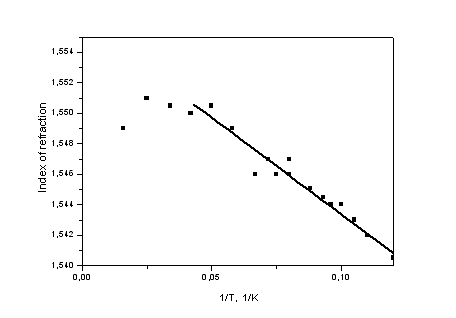
2.3 Polytetrafluoroethylene (PTFE, Teflon, in Russian - Ftoroplast)
PTFE is a white solid at room temperature, with a density of about 2.2 g/cm3. Its melting point is 327°C, though its properties remain at a useful level over a wide temperature range of -73°C to 204°C. Refractive index is ~1.43 within wide wavelength region.
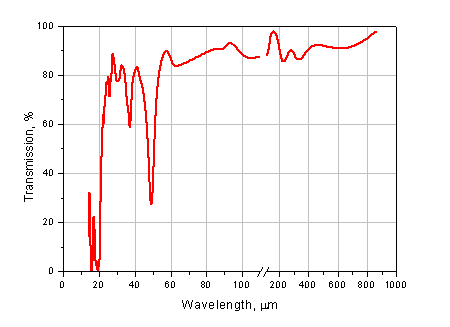
Fig. 15 Transmission of PTFE film ~0.1 mm-thick. THz region.
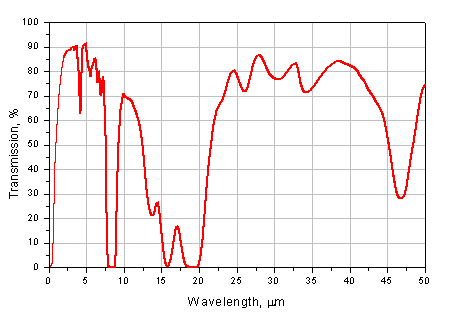
Due to good transmissionin the range 1-7 µm PTFE films are used for manufacturing of IR polarizers. First cost of such polarizers is lower than for crystalline ones. It is advantageous for their mass application in IR sensors using polarized radiation.
Typical properties of PTFE
|
As you can see all organic materials like TPX, PE and PTFE have uniform stable transmission about 80-90% starting from ~200 µm and up to 1000 µm. Surely they excellently transmit at larger wavelengths too.
Crystalline materials like silicon, quartz, and sapphire have lower transmission in THz range due to reflection losses. For silicon it is 50-54% starting from 50 µm, for quartz it is >70% starting from about 120 µm, for sapphire it is >50% starting from about 350 µm at 1- 2 mm sample thickness.
For price quotation and delivery please fill in our Request Form.
Also please pay attention we do not supply polymer and crystalline materials in blanks or as raw material. Our standard products are finished parts. Please learn more about Tydex THz devices and components from the following chapters:
- 上一篇:THz-TDS材料光学参数拟合 2016/4/6
- 下一篇:TDS10XX用户手册 2016/3/19

